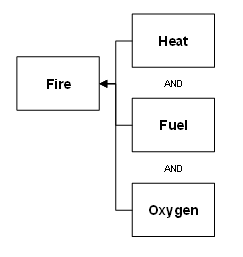|
Step #2: Why did it happen? (the analysis)
It’s important to remember in this step that every effect has “causes” (plural). While people may try to identify the single cause of an issue (commonly referred to as the “root cause”), the fact is there is not just one cause of an incident--there are causes.
The fire triangle shows us, there is no single cause for a fire; there are causes--heat, fuel and oxygen. Controlling any one of these causes will reduce the risk of the fire. Most people mistakenly believe oxygen is a “contributing factor” to a fire, meaning on it’s own it can’t produce a fire. In reality, there is no difference between a contributing factor and a cause. A cause, by definition, is required to produce an effect. Oxygen is required for fire; therefore, it is a cause of fire. On its own, oxygen will not produce a fire. Neither will heat nor fuel. Fire requires all three causes, heat, fuel and oxygen. Every effect requires all of its causes.
The most effective way to communicate all causes of an incident is through a visual format, similar to that in Fig. 2. The cause-and-effect analysis should start with a discussion of the goals that were impacted, followed by the asking of “why” questions moving to right. The simple convention is effect on left, cause on right. “Why” questions take us backwards through the failure. Visually breaking down the cause-and-effect relationships is the simplest way to document an incident during the investigation
 Fig. 2. It’s best to communicate all causes of and incident in a visual format, with effect on the left and cause on the right. Fig. 2. It’s best to communicate all causes of and incident in a visual format, with effect on the left and cause on the right.
The focus of Step #2 is on generating an accurate cause-and-effect analysis with a sufficient level of detail. During this step detail is added to the timeline, diagrams and photographs are utilized and specific steps of the processes are identified to ensure that the analysis is accurate. The facilitator is typically moving back and forth between the different tools and the cause-and-effect analysis as information becomes available. A complete analysis identifies the causes and validates them with evidence.
|